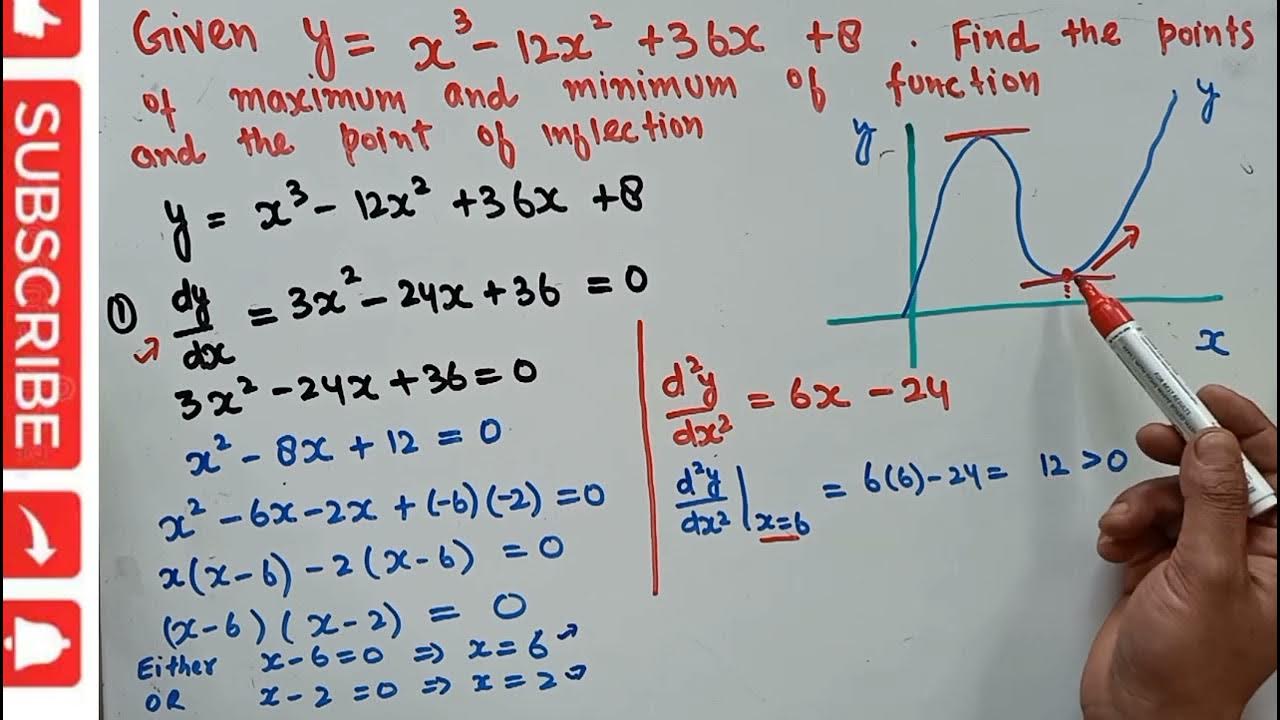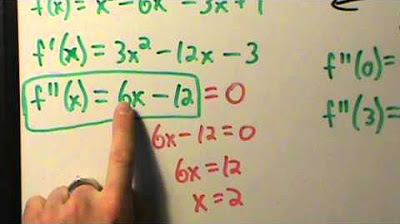Finding Concavity and Inflection Points
TLDRThe video script provides a detailed explanation on how to find concavity and inflection points of a function using the second derivative. The process begins by finding the first derivative of the given function, which is 3x^2 - 6x - 24. The second derivative is then calculated as 6x - 6. To locate the points of concavity and inflection, the second derivative is set to zero and solved, yielding a critical value of x = 1. The function's concavity is tested by evaluating the second derivative at points on either side of this critical value. The function is found to be concave down from negative infinity to 1 and concave up from 1 to infinity. The point where the concavity changes, x = 1, is identified as the inflection point. The corresponding y-value is calculated by substituting x = 1 into the original function, resulting in the inflection point being at (1, -21). The video concludes by emphasizing the importance of the second derivative in determining concavity and inflection points, and encourages viewers to subscribe for more informative content.
Takeaways
- 📚 To find concavity and inflection points, start by taking the second derivative of the function.
- 🔍 The first derivative of the given function is (3x^2 - 6x - 24), and the second derivative is (6x - 6).
- ✍️ Set the second derivative equal to zero to find critical values for concavity and inflection points: (6x - 6 = 0).
- 🔑 Solve the second derivative equation to find the critical value (x = 1).
- 📈 Use a sign chart to test intervals around the critical value to determine the concavity of the function.
- 📉 Test a point in each interval (e.g., (x = 0) and (x = 2)) by plugging it into the second derivative to check its sign.
- 📶 A negative second derivative indicates the function is concave down, while a positive second derivative indicates it is concave up.
- 🔄 At (x = 1), the concavity changes, which is the inflection point.
- 📍 The inflection point is at (x = 1, y = -21), found by substituting (x = 1) into the original function.
- 📝 The function is concave up from (x = 1) to infinity and concave down from negative infinity to (x = 1).
- ⚠️ If there are more than one critical value, check the intervals between them to determine the concavity.
- 📺 Subscribe to the channel for more educational content on mathematical concepts.
Q & A
What is the concept of concavity in calculus?
-Concavity in calculus refers to the curvature of a function. A function is said to be concave up on an interval if the graph of the function lies above or on its tangent lines on that interval, and concave down if the graph lies below or on its tangent lines.
How is the second derivative used to find concavity?
-The second derivative is used to determine the concavity by analyzing its sign. If the second derivative is positive over an interval, the function is concave up, and if it's negative, the function is concave down.
What is an inflection point?
-An inflection point is a point on the graph of a function where the concavity changes. It's where the function transitions from being concave up to concave down or vice versa.
How do you find the inflection point mathematically?
-To find an inflection point, you first find the second derivative of the function and set it equal to zero. Then you solve for x to find critical values. You test the intervals around these critical values by plugging in numbers from each interval into the second derivative to see where the concavity changes.
In the provided transcript, what is the first derivative of the function?
-The first derivative of the function in the transcript is 3x^2 - 6x - 24.
What is the second derivative of the function in the transcript?
-The second derivative of the function in the transcript is 6x - 6.
How does the sign of the second derivative indicate the concavity of the function?
-If the second derivative is positive, the function is concave up, and if it's negative, the function is concave down. The sign change indicates an inflection point.
What is the critical value found in the transcript for the second derivative?
-The critical value found in the transcript for the second derivative is x = 1.
How does the sign chart help in determining the concavity?
-A sign chart divides the number line into intervals based on the critical values of the second derivative. By testing points within each interval, you can determine the sign of the second derivative and thus the concavity over each interval.
In the transcript, what are the intervals of concavity for the function?
-In the transcript, the function is concave down from negative infinity to 1 and concave up from 1 to infinity.
How is the y-value of the inflection point found?
-The y-value of the inflection point is found by substituting the x-value of the inflection point (the critical value where the concavity changes) back into the original function.
What is the inflection point found in the transcript?
-The inflection point found in the transcript is at (1, -21).
What is the importance of subscribing to the channel as mentioned in the transcript?
-Subscribing to the channel helps support the content creator by increasing the visibility of their videos, which can lead to more comprehensive and frequent content production.
Outlines
📚 Finding Concavity and Inflection Points
This paragraph explains the concept of concavity and inflection points in calculus. It begins by stating that concavity is determined by the second derivative of a function. The first derivative of the given function, 3x^2 - 6x - 24, is calculated to find the second derivative, 6x - 6. To find points of concavity and inflection, the second derivative is set to zero and solved, yielding x = 1 as a critical value. A sign chart is used to test intervals around this critical value to determine the concavity. The function is found to be concave down from negative infinity to 1 and concave up from 1 to infinity. An inflection point, where concavity changes, is identified at x = 1, with the corresponding y-value found by substituting x = 1 into the original function, resulting in y = -21. The paragraph concludes with a summary of the method for finding areas of concavity and inflection points using the second derivative.
Mindmap
Keywords
💡Concavity
💡Second Derivative
💡Inflection Point
💡Critical Value
💡Sign of the Second Derivative
💡Number Line
💡Test Values
💡Function's Original Equation
💡Intervals
💡Substitute
💡Chart of Signs
Highlights
The concept of concavity is derived from the second derivative of a function.
To find areas of concavity and inflection points, take the first derivative of the given function: 3x^2 - 6x - 24.
The second derivative is found to be 6x - 6, which is then set to zero to find critical points.
Solving the second derivative equal to zero yields a critical value of x = 1.
A chart of signs is used to test intervals around the critical value to determine concavity.
The function is tested at x = 0 and x = 2 to check the sign of the second derivative.
A negative second derivative at x = 0 indicates the function is concave down in the interval (-∞, 1).
A positive second derivative at x = 2 indicates the function is concave up in the interval (1, ∞).
An inflection point occurs where the concavity changes, which is at x = 1 in this case.
The y-value of the inflection point is found by substituting x = 1 into the original function, resulting in y = -21.
The function is concave up from x = 1 to ∞ and concave down from -∞ to x = 1.
The only inflection point is at (1, -21), indicating a change in concavity.
The process involves setting the second derivative to zero and solving for x to find critical values.
If there's more than one critical value, it's necessary to check the intervals between them.
The second derivative is key for identifying concavity and inflection points.
The video provides a step-by-step guide on how to find concavity and inflection points using the second derivative.
The presenter encourages viewers to subscribe to the channel for more educational content.
The video concludes with an invitation for viewers to leave comments and suggestions for future video topics.
Transcripts
Browse More Related Video
5.0 / 5 (0 votes)
Thanks for rating:





